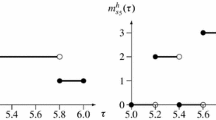Abstract
The paper presents a dynamical stochastic general equilibrium (DSGE) model for key indicators of the Russian economy. A special feature of the approach is the Keynesian microeconomic foundation, which takes into account market failures such as imperfect competition, as well as inflexible prices and wages. The second specific feature is the hypothesis of rational expectations. The model consists of a system of 17 equations describing the dynamics of key macroeconomic indicators such as GDP, inflation, interest rates, exchange rate, exports, imports, and consumption relative to its equilibrium trajectories. The model is designed to assess the nature of the reaction of key economic indicators to fluctuations in exogenous factors. Using the constructed model, the effects on key macroeconomic indicators from demand shocks, total factor productivity, and changes in the world’s interest rates are estimated. The results of modeling and calculations can be used by monetary authorities to develop monetary policy.

Similar content being viewed by others
Notes
The solution of the dual task (minimization of budget expenditures \({{P}_{{H,t}}}{{C}_{{H,t}}} + {{P}_{{F,t}}}{{C}_{{F,t}}}\) at the given composite consumption \({{C}_{t}}\)) allows us to get the same result.
REFERENCES
M. Turuntseva, “Forecasting in Russia: an overview of the main models,” Ekon. Polit., No. 1, 193–202 (2011).
I. G. Pospelov, I. I. Pospelova, M. A. Khokhlov, and G. E. Shipulina, New Principles and Methods of Development of Macro Models of the Economy and a Model of Modern Russian Economy (VTs RAN, Moscow, 2006) [in Russian].
M. Yu. Andreev and I. G. Pospelov, “Dynamic stochastic general equilibrium model with the capital,” Mat. Model. 19 (9), 49–53 (2007).
New Keynesian Macroeconomics,Vol. 1: Imperfect Competition and Sticky Prices, Ed. by G. Mankiw and P. Romer (MIT Press, Boston, 1991), p. 444.
Rational Expectations and Econometric Practice, Ed. by R. Lucas and T. Sargent (Univ. Minnesota Press, 1984), p. 689.
D. DeJong and C. Dave, Structural Macroeconometrics, 2nd ed. (Princeton Univ. Press, Princeton, 2011).
A. Mikusheva, “Estimation of dynamic stochastic general equilibrium models,” Qauntile, No. 12, 1–22 (2014).
S. Chetveriakov and G. Karasev, Exchange Rate Structural Models (IEPP, Moscow, 2005) [in Russian].
J. Heijdra Ben and F. van der Ploeg, The Foundations of Modern Macroeconomics (Oxford Univ. Press, Oxford, 2002), p. 751.
G. Calvo, “Staggered contracts in a utility-maximizing framework,” J. Monet. Econ., No. 12, 383–398 (1983).
J. Rotemberg, “Sticky prices in the United States,” J. Polit. Econ. 90, 1187–1211 (1982).
B. Heer and A. Maussner, Dynamic General Equilibrium Modelling, Computational Methods and Applications, 2nd ed. (Springer, Berlin, 2008).
J. Gali and T. Monacelli, “Monetary policy and exchange rate volatility in a small open economy,” Rev. Econ. Studies, No. 72, 707–734 (2005).
J. Gali and M. Gertler, “Inflation dynamics: A structural econometric analysis,” J. Monet. Econ. 44, 195–222 (1999).
J. Taylor. Discretion versus Policy Rules in Practice. http://web.stanford.edu/~johntayl/Papers/Discretion.PDF. Accessed April 01, 2018.
D. O. Chernyavski and N. S. Mukhanov, “Introducing the monetary policy rule into a quarterly predictive model in Kazakhstan,” Dengi Kredit, No. 5, 40–46 (2017).
D. N. Shults and I. A. Oshchepkov, “Some aspects of construction and use of dynamic stochastic general equilibrium (DSGE) models,” Vestn. Perm. Univ., Ser. Ekon., No. 4 (2016). doi 10. 17072/1994-9960-2016-4-49-65
A. Zaretski, Finding the Best Monetary Policy Option in Belarus: Results of a Simple DSGE Model. http://www.research.by/webroot/delivery/files/wp2012r06.pdf. Accessed February 03, 2016.
A. Bozhechkova et al., Building Models of Money and Foreign Exchange Markets (Inst. Gaidara, Moscow, 2018) [in Russian].
A. Yu. Knobel, “Estimation of import demand function in Russia,” Prikl. Ekonometr., No. 4, 3–26 (2011).
R. M. Melnikov, “The influence of oil price dynamics on macroeconomic indicators of the Russian economy,” Prikl. Ekonometr., No. 1, 20–29 (2010).
Author information
Authors and Affiliations
Corresponding authors
Ethics declarations
The authors declare that they have no conflicts of interest.
Rights and permissions
About this article
Cite this article
Baluta, V.I., Shults, D.N. A Version of a Dynamic Stochastic General Equilibrium Model for an Open Economy. Math Models Comput Simul 12, 519–527 (2020). https://doi.org/10.1134/S207004822004002X
Received:
Revised:
Accepted:
Published:
Issue Date:
DOI: https://doi.org/10.1134/S207004822004002X



